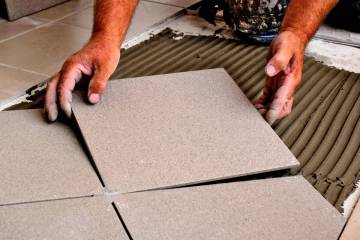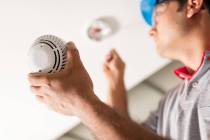Roses only need water every other day in summer
Q: How much water should I give roses here in Las Vegas? I have a newly planted Peace rose, Mr. Lincoln, Tropicana and a Radiant Perfume Grandiflora currently getting 3 gallons per day and an established Don Juan climber that gets about 4.5 gallons per day.
A: Roses should never need daily watering, even during the hottest days. If the soil was prepared correctly at planting time and the soil surface covered in wood chips, they should get watered — at the most during the hottest times — every other day. Giving trees and shrubs daily “sips” of water makes them less tolerant of the heat and could mean trouble.
After an irrigation, the soil under their canopy is wetted to about 18 to 24 inches. That probably takes about 5 to 6 gallons of water. The plants are expected to drink from this water supply until 2 to 3 gallons are gone. Then they are watered again.
Another critical point is where the water is applied. Uniformity, or how even the water is applied to the soil, is important. Embedded drip emitters should be facing upwards and somewhere between 12 to 18 inches apart and no closer than about 12 inches from the plant. As much of the soil as possible under the plant canopy should become evenly wet.
If these roses are grouped together in a rose bed, then it makes sense to use drip tubing for irrigation instead of single drip emitters. The drip tubing has identical single drip emitters embedded in their walls. It’s perfect for irrigating plant beds if plants are similar in their water and irrigation needs. Make sure these embedded emitters are facing upwards to discourage plugging.
The Don Juan rose climber, depending on its size, may require an additional two drip emitters (maybe 8 to 10 gallons total). If it’s a similar size to the shrub roses, then three or four drip emitters (5 to 6 gallons total) are enough. The size of the plant determines the amount of water to apply.
Q: I have an assortment of figs (Kadota, Desert King, Black Mission) in cloth pots. The fruit is shriveling up on the tree, so I don’t get any fruit. I don’t understand it because there was moss in the early spring, and they get water every day. Should I just shade these trees until these hot temperatures go down to 100 degrees?
A: Fig trees growing in the ground don’t have any problem producing fruit in this climate if they get enough water applied at the right time. The soil in the ground can hold a lot of water, and fig roots can explore lots of new areas to access water.
Your fig trees are growing in containers. Their roots don’t have access to as much soil and water. That doesn’t mean they use more water. They will use the same amount if they are the same size. They just need smaller amounts of water applied at times different from trees growing in the ground.
By the way, fig trees will get big so, at some point, they must be put in the ground.
Plants growing in containers need to be watered more often than plants growing in the ground. Probably the simplest way to determine when to water is using a moisture sensor like the kind they sell for houseplants.
Push this moisture sensor into the soil 3 to 4 inches deep in several locations. If the average value on the meter registers less than 5, it’s time to water.
The presence of moss tells you nothing about how to grow figs. You should water fig trees to produce new growth and produce fruit.
You will get figs if the soil around the roots doesn’t get too dry. During the heat of the summer, the plant might need irrigation two or three times a day, maybe more or maybe less often.
Use the soil moisture meter to gauge when to apply your next irrigation. Water these plants with enough water until about 20 percent of the water applied runs out the bottom.
Protect the sides of these containers from direct sunlight. The sides of dark containers can reach 165 to 170 degrees in full sun. That kind of heat kills all of the roots growing in the soil on that side.
Shade the sides of containers or grow them in larger pots. Make sure to irrigate before it gets hot, not after or during the heat.
Q: I feed my fruit trees once a week with water-soluble fertilizer combined with Alaska fish fertilizer. Then about every two weeks, I give them a granulated non-water-soluble fertilizer as well. So once a week, I soak each tree with 1.5 to 2 gallons of food and water.
A: Why so much fertilizer and why so often? The tree doesn’t gain anything from all this TLC. Adding extra fertilizer won’t make the fruit any better.
In my opinion, you’re throwing your money away. The tree just needs to be healthy so it produces the best fruit it can in your climate and soils.
This is a good time to bring up the concept of terroir. Wine grape aficionados know the term, but it also applies to other types of fruit besides grapes. Google it, but it means that the quality of a fruit depends on the climate, soils and the weather that season.
An apple, for instance, produced in Pennsylvania will not have the same qualities as the same apple produced in New Mexico. Not only that, but apple quality varies from year to year in the same location. Fruit quality has good years and bad years.
Keep your plant healthy and productive, and it will produce the best possible fruit it can given its terroir.
Q: I have a Meyer lemon tree that was planted 18 months ago and there is one lemon on it. My old tree at my old house used to be full of lemons. What may be the reason for this?
A: You moved. It is a different microclimate and, possibly, weather but most likely a different microclimate.
Meyer lemon trees produce flowers from about January through February. That is the same time we are most likely to get winter freezing temperatures. If a light winter freeze comes through in January and some of the flowers are ready to open or open, fruit from these flowers is gone.
If a second light freeze happens again a couple of weeks later when more flowers are open, then more lemons are wiped out. If a third light freeze comes through your microclimate, then the total crop is wiped out because of three light freezes.
Open flowers and small fruit of any kind can’t survive temperatures below 32 degrees. If one hard freeze comes through, dropping night temperatures to maybe 25 degrees and sticks around an hour or two, it can wipe out the entire crop for the year. New house, new microclimate.
Q: I put up some shade cloth to protect my fig trees from the heat. The new growth is good and the leaves look fine so I don’t think its water. But I think they can’t handle this heat. I will take the shade cloth down after the temperatures come back down to maybe 100 degrees.
A: I have grown 15 different varieties of figs over a period of 20 years, and none of them needed shade cloth. They were all in full sun. However, they did have lots of wood mulch covering the soil and regular irrigations applied when they were producing fruit.
The usual problem with fig fruit drying up in the heat is a lack of available water in the soil. For several reasons, the problem can be resolved simply through soil improvement.
Figs are an oasis plant, similar to palms, and the organic content of the soil near sources of water is higher. Figs in those locations have access to more water and better soils.
If you’re going to use shade cloth, never go higher than 30 to 40 percent. When using shade cloth, achieve a balance between food production and food quality. In the case of figs, the fruit needs protection from birds rather than the sun.
Bob Morris is a horticulture expert and professor emeritus of the University of Nevada, Las Vegas. Visit his blog at xtremehorticulture.blogspot.com. Send questions to Extremehort@aol.com.





























